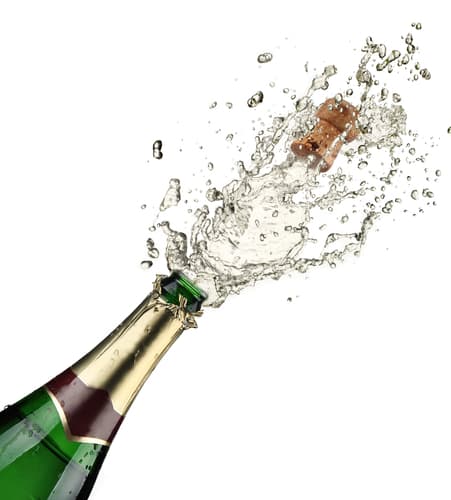Champagne Cork

A flying champagne cork is an unguided missile capable of ruining anyone’s party. Since they are small enough to pass by protective facial bones and can travel at high speeds, corks can be very dangerous projectiles and have been known to blind people. It is important to handle champagne bottles correctly and safely. Here are some tips:
- Be sure the bottle is cold before opening the champagne. The cork in a warm bottle is more likely to pop unexpectedly. Chilling champagne to 45 degrees Fahrenheit also improves its taste.
- After removing the cork’s foil covering, carefully remove the wire hood while holding the cork down with the palm of your hand.
- Point the bottle away from yourself and others.
- Place a towel over the top of the bottle and tilt it at a 45-degree angle. Grasp the cork, and slowly and firmly twist it to break the seal.
- Keeping the bottle at a 45-degree angle, hold it firmly with one hand and use the other hand to slowly turn the cork with a slight upward pull.
- Continue twisting until the cork is almost out of the neck of the bottle.
- Counter the force of the cork using slight downward pressure just as the cork breaks free from the bottle.
Fireworks
Fireworks rupture the eyeball, burn the eye and face, cut eyelids, and cause corneal abrasions in approximately two thousand people every year in the US. One quarter of these eye injuries result in permanent loss of vision or blindness. The single most dangerous type of firework is the small, explosive bottle rocket. Their erratic flight causes injuries to users and bystanders alike. Sparklers, often given to young children, burn at 1800 degrees Fahrenheit, nearly hot enough to melt gold. To avoid the dangers of fireworks, attend public firework displays instead of using fireworks at home. Amateur backyard displays are dangerous to the person lighting the fireworks and to nearby family members, friends, and neighbors. Celebrate safely by letting the professionals put on the show. At a public fireworks display, follow these safety tips to keep you and your family safe:
- Leave the lighting of fireworks to trained professionals-not only is it safer, it is also cheaper and more spectacular.
- Respect safety barriers set up to allow the pyrotechnicians (or firework professionals) to do their jobs safely.
- For the best and safest view, stand at least 500 feet, or up to a quarter of a mile, away.
- Follow directives given by event ushers and public safety personnel such as police and fire fighters.
- If you find unexploded fireworks remains, do not touch them. Immediately contact local fire or police departments.
- Most importantly, never let your child play with fireworks. Ever.
Jump-Starting Your Car
Many people suffer severe eye injuries every year because they do not take proper precautions while jump-starting their car. A spark caused by hooking up the jumper cables can ignite fumes and cause the battery to explode. Battery acid and flying battery parts can blind you. Here are few simple precautions to avoid a serious injury:
- Wear protective goggles during all phases of the procedure. Keep a pair attached to your jumper cables.
- Put out cigarettes before opening the hood. Use a flashlight, not a match, to look under the hood at night.
- Be certain the vehicles are not in contact with each other.
- Do not allow the cable clamps to touch each other.
- Attach the positive ( + ) cable (red) to the positive terminal of the dead battery first. Then attach the other end of the positive cable to the good battery.
- Attach the negative ( – ) cable (black) to the negative terminal of the good battery. Then attach the other end of the negative cable to the engine block away from the negative terminal.
- Do not attach a cable to the negative terminal of the dead battery.
- Once the engine is started, carefully remove the cables in reverse order, again not allowing the clamps to touch.
- Do not lean over the battery during the jumping process.
If an injury does occur, contact your ophthalmologist or go to the emergency room immediately.
